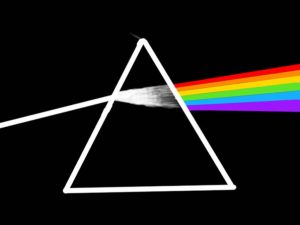
CC Image courtesy of tylenoltommy on deviantart
Category: Album
Title: The Dark Side of the Moon
Artist: Pink Floyd
Released: March 1, 1973
Genres: Art Rock, Electronic Music, Jazz, Progressive Rock, Psychedelic Rock
Album Background
Release Date and Label
“The Dark Side of the Moon” was released on March 1, 1973, in the United States and on March 16, 1973, in the United Kingdom. It was produced under the Harvest Records label in the UK and Capitol Records in the US. The album was recorded at Abbey Road Studios in London, a location synonymous with some of the greatest recordings in music history.
Artist Context
At the time of creating “The Dark Side of the Moon,” Pink Floyd was an established band but had not yet achieved the monumental success that this album would bring. Formed in 1965, Pink Floyd had gained a reputation for their psychedelic and progressive rock music, as well as their elaborate live shows.
By the early 1970s, the band had undergone several changes, most notably the departure of founding member Syd Barrett, whose mental health issues had significantly impacted the group’s early work. The remaining members—Roger Waters, David Gilmour, Richard Wright, and Nick Mason—had to find their new identity and sound.
Their previous album, “Meddle” (1971), had been well-received and hinted at the band’s potential for creating more cohesive and conceptually ambitious works. “The Dark Side of the Moon” was conceived during a period of intense creativity and experimentation. It represented a shift towards more structured compositions, lyrical depth, and conceptual unity. The album addressed themes such as conflict, greed, time, death, and mental illness, reflecting the band’s experiences and observations of the world around them.
This project marked a pivotal moment in Pink Floyd’s career, solidifying their place as pioneers of progressive rock and setting the stage for their future success. “The Dark Side of the Moon” not only transformed the band’s career but also became a cultural and musical milestone, influencing countless artists and remaining relevant decades after its release.
Concept and Inspiration
Themes and Messages
“The Dark Side of the Moon” is a concept album that explores various aspects of the human experience, focusing on themes of existentialism and the pressures of modern life. The album’s central themes include:
- Time: The passage of time and its inevitable impact on life is a recurring theme, most notably in the track “Time,” which examines how quickly life passes and the importance of making the most of it.
- Mental Illness: Inspired by the band’s experiences with former member Syd Barrett, mental illness is a poignant theme. “Brain Damage” and “Eclipse” touch on the fragility of the human mind and the thin line between sanity and madness.
- Conflict and Division: Songs like “Us and Them” address social and political conflicts, highlighting themes of division, war, and human nature’s propensity for conflict.
- Materialism and Greed: “Money” critiques the obsession with wealth and material possessions, questioning the true value and cost of money.
- Mortality: The album confronts the inevitability of death, with tracks like “The Great Gig in the Sky” exploring the fear and acceptance of mortality.
- Existential Reflection: Throughout the album, there is a pervasive sense of introspection and philosophical inquiry, questioning the meaning of life and the individual’s place in the universe.
Inspiration
The inspiration for “The Dark Side of the Moon” came from a combination of personal experiences, societal observations, and the band’s creative ambitions:
- Syd Barrett’s Influence: The mental decline of Syd Barrett had a profound impact on the band. His struggles with mental illness and his departure from Pink Floyd deeply influenced the album’s exploration of psychological themes.
- Personal and Collective Stress: The pressures and stresses of modern life, experienced both personally by the band members and observed in the world around them, inspired much of the album’s lyrical content. The themes of time, money, and conflict reflect the band’s own concerns and the societal issues of the early 1970s.
- Philosophical and Existential Questions: The band members, particularly Roger Waters, were influenced by philosophical and existential ideas. Waters’ introspective lyrics delve into questions about the nature of existence, the human condition, and the passage of time.
- Innovative Studio Techniques: Inspired by the potential of studio technology, the band experimented with advanced recording techniques, synthesizers, and sound effects. Alan Parsons, the album’s engineer, played a crucial role in shaping its innovative sound.
- Live Performances: Some of the material on “The Dark Side of the Moon” was developed and refined during live performances before the album’s recording. The band’s interaction with their audience and the feedback they received helped shape the final product.
“The Dark Side of the Moon” is a reflection of Pink Floyd’s journey as a band and their responses to the world around them. Its themes and messages continue to resonate with listeners, making it one of the most enduring and influential albums in music history.
Songwriting and Recording
Writing Process
The writing process for “The Dark Side of the Moon” began in 1971 and continued into 1972. The band members—Roger Waters, David Gilmour, Richard Wright, and Nick Mason—collaborated closely, bringing together their individual ideas and musical influences. The themes of the album were largely influenced by Roger Waters, who wrote most of the lyrics and conceptualized the overall narrative.
Early Development
Much of the material for the album was developed during live performances. In early 1972, the band began performing an early version of the album, then titled “Eclipse,” during their concerts. This allowed them to test the songs and refine the arrangements based on audience reactions. These live performances were crucial in shaping the final versions of the tracks.
Recording Process
Studios Used
- Abbey Road Studios, London: The primary recording sessions for “The Dark Side of the Moon” took place at Abbey Road Studios, starting in May 1972 and continuing intermittently until January 1973. The band chose Abbey Road for its state-of-the-art facilities and its historical significance.
Notable Collaborations and Contributions
- Alan Parsons: Alan Parsons, the album’s engineer, played a vital role in the recording process. His expertise in studio technology and innovative recording techniques helped create the album’s distinctive sound. Parsons’ contributions included the use of advanced synthesizers, tape loops, and sound effects, as well as the meticulous mixing of the tracks.
- Clare Torry: The album features a powerful vocal performance by Clare Torry on “The Great Gig in the Sky.” Torry was brought in by Parsons and improvised her now-iconic vocal lines during the recording session, adding an emotional depth to the track.
- Doris Troy, Lesley Duncan, Liza Strike, and Barry St. John: These backing vocalists contributed to the rich vocal harmonies on several tracks, including “Us and Them” and “Brain Damage.”
- Dick Parry: Dick Parry played the saxophone solos on “Money” and “Us and Them,” adding a soulful, jazzy element to the album’s sound.
Innovative Techniques and Equipment
- Synthesizers and Sound Effects: The band made extensive use of synthesizers, particularly the EMS VCS 3 and the Synthi A. These were used to create the album’s atmospheric soundscapes and unique textures. The opening track, “Speak to Me,” features a collage of sound effects, including heartbeats, ticking clocks, and cash registers, setting the tone for the album’s exploration of life’s various pressures.
- Tape Loops and Sequencing: “Money” is notable for its distinctive 7/4 time signature and the use of tape loops to create the sound of cash registers and coins. This technique added a rhythmic, mechanical quality to the song that perfectly complemented its critique of materialism.
- Quadraphonic Sound: The band experimented with quadraphonic sound, an early form of surround sound, during the mixing process. Although the album was primarily released in stereo, the quadraphonic mixes added to the immersive experience of the album.
The writing and recording process of “The Dark Side of the Moon” was characterized by collaboration, innovation, and meticulous attention to detail. The band’s willingness to experiment with new technologies and their commitment to exploring complex themes resulted in an album that remains a landmark in the history of music.
Producers and Sound
Key Producers and Their Contributions
- Pink Floyd: The band members themselves—Roger Waters, David Gilmour, Richard Wright, and Nick Mason—played a crucial role in producing “The Dark Side of the Moon.” Their collaborative approach ensured that each member’s contributions and ideas were integral to the final product. Roger Waters, in particular, drove the conceptual and lyrical direction of the album, while David Gilmour’s guitar work and vocal contributions were essential to its sound.
- Alan Parsons: Alan Parsons served as the primary engineer and played a significant role in shaping the album’s innovative sound. His technical expertise and creative use of studio technology were instrumental in achieving the album’s distinctive audio effects and atmospheric qualities. Parsons’ contributions included:
- Sound Effects: Incorporating a variety of sound effects, such as the heartbeats, ticking clocks, and cash registers, which added depth and thematic cohesion to the album.
- Innovative Recording Techniques: Utilizing techniques like tape loops, multi-track recording, and quadraphonic sound to create a rich and immersive listening experience.
- Mixing and Mastering: Ensuring the final mix was balanced, cohesive, and sonically impressive, contributing to the album’s polished and professional sound.
Sound and Musical Style
“The Dark Side of the Moon” is characterized by its sophisticated and cohesive sound, blending various musical styles and genres to create a unique and immersive experience. The album’s overall sound and style can be described as follows:
- Progressive Rock: The album is a quintessential example of progressive rock, known for its complex structures, experimental approach, and conceptual depth. Pink Floyd’s use of extended instrumental passages, intricate arrangements, and thematic continuity are hallmarks of the genre.
- Psychedelic Influences: Building on their earlier work, Pink Floyd incorporated elements of psychedelic rock, including atmospheric soundscapes, ethereal vocals, and surreal lyrics. This influence is particularly evident in tracks like “The Great Gig in the Sky” and “Any Colour You Like.”
- Electronic Music: The use of synthesizers, such as the EMS VCS 3 and Synthi A, played a crucial role in defining the album’s sound. Tracks like “On the Run” showcase the band’s experimentation with electronic music, featuring sequenced patterns and synthetic textures.
- Jazz Elements: The inclusion of saxophone solos by Dick Parry on “Money” and “Us and Them” added a jazz-infused layer to the album. These contributions provided a contrast to the rock and electronic elements, enriching the overall sonic palette.
- Psychoacoustic Effects: The album employs various psychoacoustic techniques to create an immersive listening experience. This includes the strategic placement of sound effects, dynamic range manipulation, and spatial audio techniques that give the impression of sounds moving around the listener.
- Emotional and Atmospheric Vocals: The vocal performances on the album are diverse and emotionally charged. Clare Torry’s improvised vocalizations on “The Great Gig in the Sky” are a standout example, providing an intense, wordless expression of emotion. The harmonies and vocal arrangements throughout the album contribute to its atmospheric and introspective quality.
“The Dark Side of the Moon” is a masterclass in production, showcasing Pink Floyd’s ability to blend various musical styles and incorporate innovative recording techniques. The contributions of the band members and Alan Parsons were instrumental in achieving the album’s distinctive sound, which remains a benchmark in the history of music production. The album’s sophisticated blend of progressive rock, electronic music, and jazz elements, along with its use of sound effects and psychoacoustic techniques, create an immersive and timeless listening experience.
Track Analysis
Track listing
- Speak to Me
- Breathe (In the Air)
- On the Run
- Time
- The Great Gig in the Sky
- Money
- Us and Them
- Any Colour You Like
- Brain Damage
- Eclipse
Standout Elements, Lyrics, and Themes
- Cohesive Concept: Each track contributes to the album’s exploration of existential themes, creating a narrative that flows seamlessly from start to finish.
- Sound Effects and Innovation: The use of non-musical sound effects, synthesizers, and innovative recording techniques adds depth and texture to the album.
- Emotional Depth: The lyrics and musical arrangements evoke a wide range of emotions, from anxiety and despair to introspection and transcendence.
- Timeless Relevance: The themes of “The Dark Side of the Moon” remain relevant, addressing universal human experiences and societal issues that continue to resonate with listeners today.
Key Tracks
- “Speak to Me”
- This opening track sets the thematic tone for the entire album. It is an instrumental collage of sound effects that introduces key motifs heard throughout the record, including heartbeats, ticking clocks, and snippets of voices. It acts as a prelude, drawing listeners into the immersive experience.
- “Breathe (In the Air)”
- Following “Speak to Me,” this track establishes the album’s contemplative mood. Its lyrics encourage living in the moment and question the rush of modern life. The soothing melody and atmospheric soundscape are characteristic of Pink Floyd’s progressive rock style.
- “On the Run”
- This instrumental track features synthesizer sequences and sound effects that create a sense of frantic motion. It reflects the pressures and anxieties of travel and modern life. Its electronic experimentation marks one of the band’s significant forays into electronic music.
- “Time”
- One of the album’s standout tracks, “Time” addresses the fleeting nature of life and the inevitability of aging. The song features a memorable intro with synchronized clocks and alarms, followed by a powerful guitar solo by David Gilmour. Its lyrical depth and musical complexity make it a key highlight of the album.
- “The Great Gig in the Sky”
- This track stands out for its emotional intensity and Clare Torry’s wordless vocal performance, which conveys a powerful sense of mortality and existential reflection. The combination of Richard Wright’s piano and Torry’s vocals creates an unforgettable and haunting piece.
- “Money”
- “Money” is one of the most commercially successful tracks from the album. It features a distinctive 7/4 time signature and memorable bassline, along with sound effects of cash registers and coins. The song critiques materialism and greed, themes central to the album’s message. Dick Parry’s saxophone solo and Gilmour’s guitar solo add to its dynamic structure.
- “Us and Them”
- This track addresses themes of conflict and division, both social and political. Its poignant lyrics and gentle, melodic composition contrast with the powerful saxophone solos by Dick Parry. The song’s exploration of human conflict is both timeless and deeply moving.
- “Any Colour You Like”
- An instrumental track that provides a musical interlude between the more lyrically driven songs. Its use of synthesizers and guitar effects continues the album’s exploration of sound and space. The title suggests themes of choice and individual perception.
- “Brain Damage”
- Often interpreted as a reflection on Syd Barrett’s mental health struggles, this track explores themes of insanity and the fine line between sanity and madness. The lyrics are introspective and haunting, culminating in the famous line, “I’ll see you on the dark side of the moon.”
- “Eclipse”
- The album’s closing track ties all the themes together, summarizing the human experience’s breadth—from joy and sorrow to conflict and unity. Its powerful climax, with the repeated refrain “And everything under the sun is in tune, but the sun is eclipsed by the moon,” leaves a lasting impact. The track fades out with a heartbeat, bringing the album full circle.
“The Dark Side of the Moon” is a landmark album that combines profound lyrical content with groundbreaking musical innovation. Each track plays a vital role in conveying the album’s central themes, making it a timeless masterpiece that continues to captivate and inspire audiences worldwide.
Awards and Nominations
Grammy Awards
-
- Nominated for Best Engineered Non-Classical Recording in 1974.
- Inducted into the Grammy Hall of Fame in 1999, recognizing its lasting significance and influence in the music industry.
NME Awards
-
- Won Best Album in 1973.
Classic Rock Roll of Honour Awards
-
- Album of the Year in 2008.
Other Recognitions
-
- Inducted into the Library of Congress’s National Recording Registry in 2012 for being “culturally, historically, or aesthetically significant.”
- Frequently appears on various “Greatest Albums of All Time” lists by publications such as Rolling Stone, Q Magazine, and The Guardian.
Sales and Charts
Album Sales
- Worldwide Sales: Over 45 million copies sold globally, making it one of the best-selling albums of all time.
- US Sales: Over 15 million copies sold, certified 15x Platinum by the RIAA.
- UK Sales: Over 4.5 million copies sold, certified 14x Platinum by the BPI.
Chart Positions
-
Billboard 200 (US):
- Peaked at #1 and remained on the chart for 741 weeks from 1973 to 1988, setting a record for the longest-charting album in Billboard history.
- Returned to the chart multiple times, including during its 20th and 30th anniversaries.
-
UK Albums Chart:
- Peaked at #2 and remained on the chart for 364 weeks.
-
Other Notable Chart Positions:
- Topped charts in various countries, including Canada, Australia, and New Zealand.
- Continued to appear on charts worldwide during reissues and anniversary editions.
Certifications
-
United States (RIAA):
- 15x Platinum (15 million units), Diamond certification.
-
United Kingdom (BPI):
- 14x Platinum (4.5 million units).
-
Canada (Music Canada):
- 2x Diamond (2 million units).
-
Australia (ARIA):
- 14x Platinum (980,000 units).
-
Other Certifications:
- Multi-Platinum in various countries, including Germany, France, and Italy.
“The Dark Side of the Moon” has not only garnered critical acclaim and numerous awards but also achieved extraordinary commercial success, solidifying its status as one of the most influential and enduring albums in music history. Its impressive sales and chart performance reflect its widespread appeal and the profound impact it has had on generations of listeners.
Influence and Long-Term Impact
Influence on Other Artists
- Musical Innovation: “The Dark Side of the Moon” set new standards for studio production and album cohesion. Its use of synthesizers, tape loops, and innovative recording techniques influenced countless artists across various genres. The album’s success encouraged other musicians to experiment with soundscapes and thematic concepts in their own work.
- Concept Albums: The album is a landmark in the genre of concept albums, demonstrating how a collection of songs can be woven together to create a unified narrative and emotional experience. Artists like Genesis, Yes, and even contemporary acts such as Radiohead and Tool have cited Pink Floyd’s work as a major influence on their approach to album-making.
- Progressive Rock: “The Dark Side of the Moon” is often cited as a defining work in progressive rock. Its sophisticated musical arrangements, elaborate live shows, and thematic depth have inspired bands and artists within the genre to push boundaries and explore complex musical ideas.
- Production Techniques: The album’s pioneering use of studio technology and sound effects has been widely influential. Modern producers and engineers often cite Alan Parsons’ work on the album as a significant reference point for high-quality, immersive sound production.
Impact on the Music Industry
- Music Videos: The album’s visual presentations, especially its iconic cover art designed by Hipgnosis and George Hardie, helped to elevate the importance of album artwork in the music industry. Its visually striking imagery and concept-driven approach set a precedent for future music videos and album designs.
- Chart Longevity: “The Dark Side of the Moon” broke records for its longevity on the charts, including its unprecedented 741 weeks on the Billboard 200. This commercial success demonstrated the potential for albums to achieve lasting popularity and influence over decades.
- Album Format: The album’s success highlighted the value of the full-length album format in an era increasingly focused on singles. It reinforced the idea that a cohesive, concept-driven album could achieve both critical acclaim and commercial success.
Lasting Significance in the Artist’s Career
- Career Milestone: For Pink Floyd, “The Dark Side of the Moon” is considered one of the band’s crowning achievements. It solidified their status as one of the most innovative and influential bands in rock history. The album’s success and enduring popularity have remained a defining element of the band’s legacy.
- Cultural Impact: The album has become a cultural touchstone, frequently referenced and parodied in various media. Its themes and music continue to resonate with new generations, maintaining its relevance in popular culture.
- Reissues and Celebrations: The album has been reissued and celebrated multiple times, including its 30th, 40th, and 50th anniversaries. Special editions, remixes, and live performances have kept the album in the public eye, introducing it to new audiences and reinforcing its status as a classic.
Conclusion: “The Dark Side of the Moon” by Pink Floyd
Summary
“The Dark Side of the Moon” by Pink Floyd, released in 1973, is a landmark album that remains one of the most influential and enduring works in music history. Its importance can be summarized through several key points:
- Innovative Production: The album is celebrated for its groundbreaking use of studio technology and production techniques. Alan Parsons’ role as the engineer, combined with the band’s experimentation with synthesizers, tape loops, and sound effects, set new standards for audio production.
- Conceptual Depth: As a concept album, “The Dark Side of the Moon” explores profound themes such as the passage of time, mental illness, materialism, and human conflict. The album’s cohesive narrative and thematic unity demonstrated how a collection of songs could tell a compelling, interconnected story.
- Cultural Impact: The album’s iconic cover art, designed by Hipgnosis, and its visual and thematic elements have had a lasting impact on album artwork and music videos. Its success on the charts, including an unprecedented run of 741 weeks on the Billboard 200, highlighted the potential for albums to achieve enduring popularity.
- Influence on Music: The album has influenced countless artists and bands across genres, from progressive rock to electronic music. Its innovative sound and thematic complexity have inspired subsequent generations of musicians and producers.
- Commercial Success: With over 45 million copies sold worldwide and numerous certifications, “The Dark Side of the Moon” remains one of the best-selling albums of all time. Its impressive sales and chart performance reflect its widespread appeal and the profound connection it has established with listeners.
Final Thoughts
“The Dark Side of the Moon” is more than just an album; it is a cultural phenomenon and a benchmark in the history of music. Its ability to combine artistic ambition with commercial success is a testament to Pink Floyd’s vision and creativity. The album’s exploration of deep, existential themes through its innovative use of sound and production has solidified its place as a timeless masterpiece.
From a personal perspective, “The Dark Side of the Moon” represents the pinnacle of progressive rock and concept albums. Its seamless integration of music, lyrics, and technology creates an immersive experience that continues to captivate and inspire. The album’s influence on the music industry and its ability to resonate with listeners across generations underscores its significance as a work of art. Its legacy endures not only through its continued popularity but also through its impact on the evolution of music and album production.


















Leave a Reply